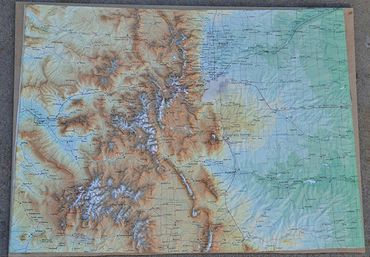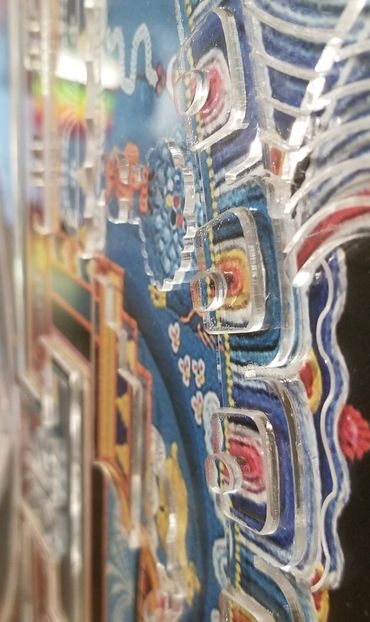Fort Ticonderoga tactile maps
The Fort Ticonderoga museum asked us to create five tactile maps of different areas as they would look around 1777. We used available historic maps of the areas, using them as overlays we sculped them in foundry wax, made molds and then cast them. The color is permanently imbedded in the casting resin to ensure years of use.




5Steps to Colorado
By using Incremental Scaling© we can teach people to have a very true understanding of the scale of very large, very small or intangible objects. In this series of models people are guided through five scales of models to have a solid understanding of how big the state of Colorado is. The series we call 5Steps to Colorado has been tested by over 230 people and has been modified over a dozen times based on feedback from users.





May D&F Clocktower, Denver Colorado
This tactile model shows some of the methods we use to research and test the best solutions to every one of our projects. At every stage we test our products with people who are blind, visually impaired and sighted to ensure that we are using effective textures, sizes, colors, and details to convey the
necessary information.



NCAR Tactile Art Symposium
We made this interactive and yes, immersive, exhibit for the NCAR Tactile Art Symposium. Its intention was to show how to stimulate all the senses within one experience. During the two days it was up, more than 50 sighted and blind people went through it, many of them more than once. To simulate walking through a dense rainforest we installed soft foam "branches", fabric vines, a bumpy but safe floor, a gentle breeze, rainforest sounds, and the smell of various plants.




Denver Art Museum - Rembrandt: Painter as Printmaker
Rembrandt: Painter as Printmaker was one of the most challenging exhibits for us to design. To illustrate what a copper plate engraving is and how Rembrandt used them in his prints was the goal given by the museum. To accomplish this we created two tactile pieces. One showed what intaglio grooves look and feel like when greatly enlarged. The three different types of intaglio grooves were filled with black silicone to simulate the look and apparent feel of ink as it lays in the grooves. At the top, in the same scale, is an enlargement of the edge of a penny for a more visceral feel for the scale.
The other piece showed a real copper plate with oversized grooves and a corresponding piece of paper which had been pressed into the plate. You can see and feel the impression the plate makes in the paper and how the artist had to etch in reverse to create the intended image. With the help of Dawn Spencer Hurwitz of DSH Perfumes in Boulder, we also added the scent of old paper and printers ink to this piece. Every time someone turned the page they smelled part of the process the artist would have smelled.







Read more about Proximity's Rembrandt tactile
Check out this interview with Matt Gesualdi by the Denver Art Museum
Mission to Nocterra
This unique interactive exhibit is possibly the world's first pitch-black puzzle room. Built within the Colorado Center for the Blind, Proximity designed, built and tested it many times before showing at Maker Faire Denver and the National Federation of the Blind Colorado state convention. Although hundreds of people went through it only eight people, five designers and three consultants, ever saw it with the lights on. Fully accessible, this exhibit put blind and sighted people on more level ground in a safe, non-frightening environment to solve individual puzzles in a pitch-black room.
Themed with an alien/government cover-up design and back story, people were asked to use antibacterial wipes to keep human germs off the alien items. Even in 2018 this was very much appreciated by people knowing that everyone before them had done the same. During the two days of Maker Faire over 250 people experienced it. The next weekend at the National Federation of the Blind Colorado state convention another 88 people went through it. By far this was the most well-attended and received interactive exhibit for Proximity.





Read more about Mission to Nocterra
Check out the articles in 303 Magazine and Denverite
Denver Art Museum - The Light Show
The Light Show exhibit showed many different uses and interpretations of the word "light", including enlightenment. In 1995 the Denver Art Museum (DAM) commissioned and was granted permission for a permanent Buddhist sand mandala. Many years later when the mandala was brought out again for The Light Show, the DAM asked Proximity to design a way for people with visual impairments to be able to see this piece. We tested and developed this tactile exhibit highlighting the different designs, patterns and proper hierarchy of the reading order for the mandala. This exhibit was up for much more than a year and touched by many, many people.







Watch the video
Check out a video produced by the Denver Art Museum. It shows the
original Buddhist mandala on a table and our tactile mandala on the wall
being used by patrons.
The Broken Column - Frida Kahlo
During the pandemic we played and experimented. We were inspired by Frida Kahlo's The Broken Column. This was an experiment to make a 2D painting into a proper 3D tactile. Yes, we could have 3D printed it and yes, used a 5-axis mill if we'd had access to one, but the form is organic. Making an organic form by hand ensures it feels organic and lifelike. Making it with different materials gives each part a different temperature, which you cannot get with a 3D printed, single material piece.








